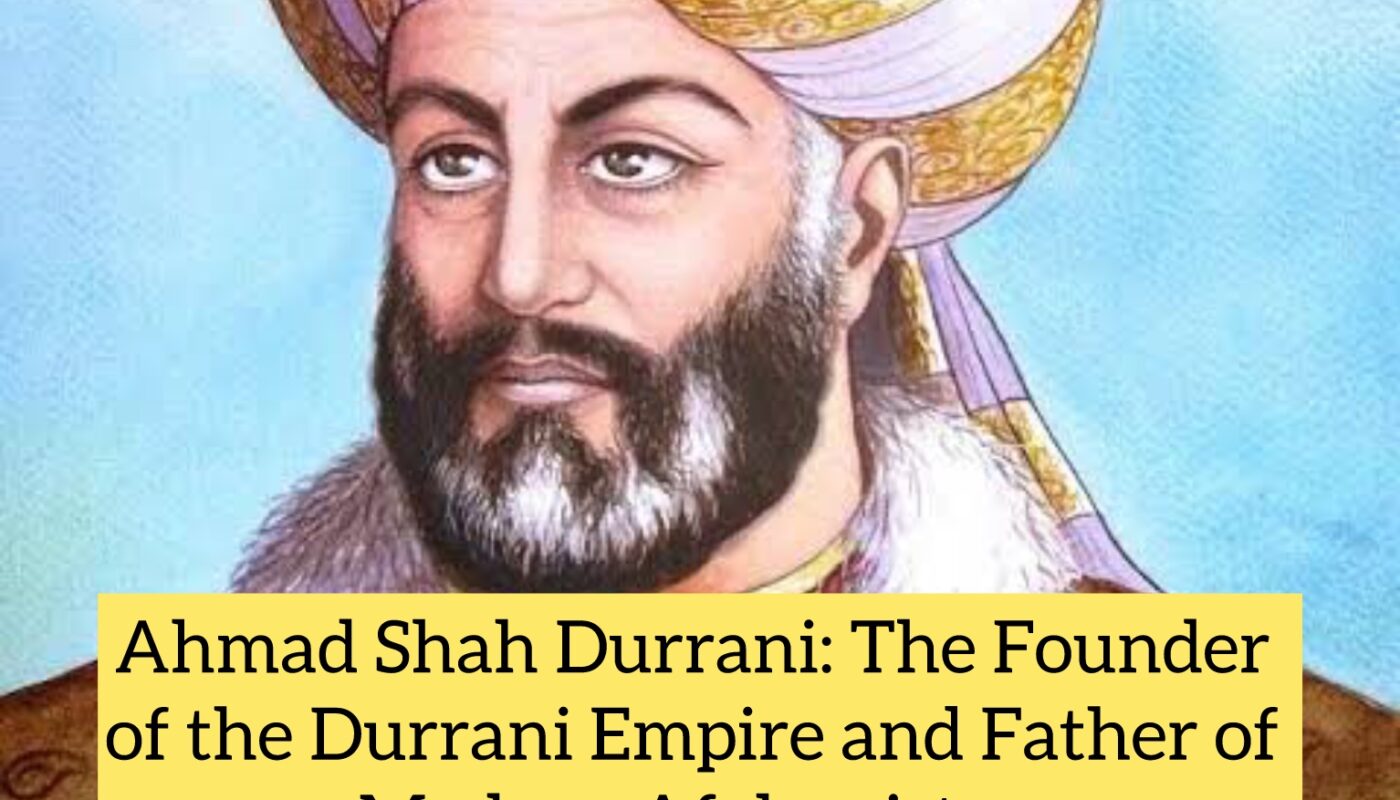Introduction
Ahmad Shah Durrani, also known as Ahmad Shah Abdali, is considered the founder of modern Afghanistan and the first ruler of the Durrani Empire. Born in 1722, Ahmad Shah’s legacy is one of military brilliance, strategic leadership, and nation-building. He played a pivotal role in shaping the modern political and territorial boundaries of Afghanistan, earning the title “Father of the Nation”.
Ahmad Shah’s reign, which spanned from 1747 to 1772, witnessed both the rise and eventual fragmentation of the empire. His ability to unify the various Pashtun tribes, his military prowess, and his diplomatic skill in navigating complex regional politics established his historical significance. Through his leadership, the foundation of a unified Afghan state was laid, setting the stage for future generations.
Early Life and Background
Birth and Ancestry
Ahmad Shah Durrani was born in 1722 in Herat, a city in the western part of modern-day Afghanistan. He belonged to the Sadozai clan of the Pashtuns, an ethnic group that would later play a central role in Afghan history. His family had a long history of military and political involvement, with close ties to the Safavid rulers of Persia. His father, Zaman Shah, was a minor Afghan noble, and his grandfather, Mahmud Shah, had served as a prominent military leader in the Safavid Empire.
Ahmad Shah’s upbringing was marked by an exposure to both Persian and Afghan cultures. His early life was spent in the court of the Safavid dynasty, where he became well-versed in the art of war and diplomacy. He was initially known as Ahmad Khan, and his role in the broader regional politics of the time would develop through his involvement in Persian and Afghan affairs.
Rise to Power
The Decline of the Safavid Empire and the Afghan Tribal Confederations
By the early 18th century, the Safavid Empire was in steep decline due to internal conflicts, invasions from the Ottoman Empire, and the growing power of local warlords. The weakening of the Safavids created an opportunity for various tribes and military leaders in Afghanistan to assert their independence.
Ahmad Shah’s rise to power is inextricably linked to the weakening of the Safavid influence over Afghanistan. Initially, Ahmad Khan served in the Safavid army and later under Nader Shah, the powerful Persian ruler who temporarily revived Persian fortunes.
In 1739, Nader Shah invaded India and later became the emperor of Persia, defeating the Mughal Empire and acquiring vast riches. Ahmad Khan, who had served in Nader Shah’s army, earned the trust and favor of his superior. However, in 1747, following Nader Shah’s assassination and the subsequent collapse of his empire, Ahmad Khan returned to Afghanistan, where the political vacuum provided an opportunity for him to assert leadership.
The Gathering of the Tribes and the Accession to Power
In 1747, Ahmad Khan gathered a tribal council (known as a Loya Jirga), which included influential leaders from various Afghan tribes, including the Pashtuns and other ethnic groups. At this council, Ahmad Khan was elected as the new leader and was given the title of “Ahmad Shah” (Ahmad Shah Durrani), marking the birth of the Durrani Empire. This was a pivotal moment in Afghan history, as Ahmad Shah Durrani’s leadership united disparate tribal factions into a cohesive political entity.
The Durrani Empire and Its Expansion
Consolidation of Power
As the new ruler of Afghanistan, Ahmad Shah Durrani worked tirelessly to consolidate his authority over the diverse tribal and regional groups within his empire. His leadership was characterized by his ability to unify Pashtun and other Afghan tribes under a central authority, something that had been lacking for centuries. Ahmad Shah established his capital in Kandahar, an ancient city that would serve as the heart of his empire.
In addition to unifying the Afghan tribes, Ahmad Shah implemented a series of reforms to strengthen his rule. He built a centralized administration, established taxation systems, and promoted trade and infrastructure development, all of which helped consolidate his empire and boost its economy.
Expansion into India and the Sikh Kingdoms
Ahmad Shah Durrani’s military ambitions extended beyond Afghanistan’s borders. One of his most significant achievements was the series of campaigns he launched into northern India. These military expeditions were aimed at both securing Afghan influence in the region and asserting control over valuable trade routes.
Ahmad Shah’s most notable military campaign was his invasion of India in 1748. He successfully captured parts of Punjab and Kashmir, weakening the Mughal Empire’s hold over northern India. During these campaigns, Ahmad Shah faced strong resistance from the local Indian rulers, particularly the Sikhs in the Punjab region.
Ahmad Shah Durrani’s invasion of India also led to his involvement in several battles against the growing Maratha and Sikh forces. The First Battle of Panipat in 1761 was particularly significant. Ahmad Shah, with the help of Afghan allies, inflicted a devastating defeat on the Maratha Confederacy, a major power in India. This victory, however, did not result in long-term Afghan control over India, as Ahmad Shah’s empire was not sufficiently strong to maintain sustained dominion over the subcontinent.
The Sikh Resistance and the Decline of Afghan Influence in India
Ahmad Shah Durrani’s attempts to control the Sikh kingdoms in Punjab were less successful. The Sikhs, led by Maharaja Ranjit Singh, mounted a powerful resistance against Afghan incursions, and by the time of Ahmad Shah’s death in 1772, the Sikh Empire had already begun to emerge as a formidable force in the region.
Internal Challenges and the Fragmentation of the Empire
While Ahmad Shah Durrani’s reign saw great territorial expansion and military success, his empire faced significant internal challenges. One of the most pressing issues was the tribal loyalty to central authority. Afghanistan, even under Ahmad Shah, was a land of various tribes, each with its own local interests and power bases. The central authority of the Durrani Empire often struggled to maintain control over the more distant regions.
Additionally, Ahmad Shah faced increasing rivalries with his own family members and tribal leaders. These rivalries would contribute to the eventual fragmentation of the empire after his death. The rise of regional powers within Afghanistan, such as the Barakzai and Khanate of Kabul, undermined the unity Ahmad Shah had worked so hard to establish.
Death and Legacy
Ahmad Shah Durrani passed away in 1772 at the age of 50. His death marked the beginning of a period of instability in the Durrani Empire. His son, Timur Shah Durrani, succeeded him, but the empire soon began to decline due to internal strife, tribal infighting, and the weakening of central control.
Nevertheless, Ahmad Shah Durrani’s legacy as the founder of Afghanistan remains indelible. He is considered the “Father of the Nation” by many Afghans, and his establishment of a centralized Afghan state paved the way for the political identity of modern-day Afghanistan. His efforts to unify the Pashtuns, promote a sense of Afghan nationalism, and create a relatively stable political order in a region traditionally marked by tribal conflicts laid the groundwork for future Afghan rulers.
Legacy and Commemoration
Ahmad Shah Durrani’s legacy is widely celebrated in Afghanistan. His reign is viewed as a period of political unification, military prowess, and expansion. In addition to his role in building a nation-state, Ahmad Shah is remembered for his cultural contributions, which included the promotion of Islamic learning, arts, and architecture.
In Afghanistan today, Ahmad Shah Durrani’s memory is enshrined in various monuments and memorials. He is particularly honored at the Shrine of Ahmad Shah Durrani in Kandahar, which is a site of national importance. His status as the founder of Afghanistan is cemented in Afghan history, and his figure continues to be a symbol of unity and resilience in the face of external and internal challenges.
Conclusion
Ahmad Shah Durrani was not only a military leader and conqueror but also a visionary who laid the foundations for the modern state of Afghanistan. His ability to unite diverse Afghan tribes and his efforts to assert Afghan power on the regional and international stage have earned him a lasting place in history. Despite the challenges and eventual fragmentation of the Durrani Empire, Ahmad Shah’s achievements are central to the historical narrative of Afghanistan. His leadership and legacy continue to inspire generations, making him one of the most significant figures in South Asian and Central Asian history.



